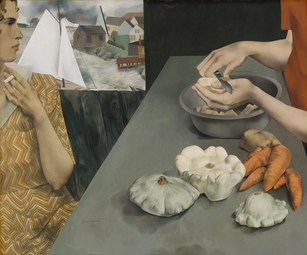| Peter Blume | |
|---|---|
 The Rock, 1944-1948, in the collection of the Art Institute of Chicago The Rock, 1944-1948, in the collection of the Art Institute of Chicago | |
| Born | (1906-10-27)October 27, 1906 Smarhoń, Russian Empire |
| Died | November 30, 1992(1992-11-30) (aged 86) New Milford, Connecticut |
| Nationality | American |
| Known for | Painting |
| Movement | Folk art, Precisionism, Parisian Purism, Cubism, Surrealism |
Peter Blume (27 October 1906 – 30 November 1992) was an American painter and sculptor. His work contained elements of folk art, Precisionism, Parisian Purism, Cubism, and Surrealism.
Biography
Blume, born in Smarhon, Russian Empire to a Jewish family, emigrated with his family to New York City in 1912; the family settled in Brooklyn. He studied art at the Educational Alliance, the Beaux-Arts Institute of Design, and the Art Students League of New York, establishing his own studio by 1926. He trained with Raphael Soyer and Isaac Soyer, exhibited with Charles Daniel, and was patronized by the Rockefeller family. Blume married Grace Douglas in 1931; they had no surviving children. In 1948, Blume was elected into the National Academy of Design as an Associate member, and became a full member in 1956.
Works
An admirer of Renaissance technique, Blume worked by drawing and making cartoons before putting his work on canvas. He received a Guggenheim Fellowship in 1932 and spent a year in Italy. His first major recognition came in 1934 with a first prize for South of Scranton at a Carnegie Institute International Exhibition. The painting was inspired by a trip across Pennsylvania in an old car that required frequent repair. Eternal City (1934–1937) was politically charged, portraying Benito Mussolini as a jack-in-the-box emerging from the Colosseum; as a one-man, one-painting exhibition, it excited considerable attention from critics and audiences. This painting was inspired by Blume's trip to Italy which he took as a Guggenheim Fellow in 1932. After the trip from Rome, it took Blume 5 years to create this piece of work. In 1943 when Mussolini was deposed from power, the Museum of Modern Art purchased the artwork for its permanent collection within that same week.
Blume worked for the Section of Painting and Sculpture of the U.S. Treasury Department, painting at least two post office murals, in Geneva, New York, and Canonsburg, Pennsylvania.
Blume's works often portrayed destruction and restoration simultaneously. Stones and girders made frequent appearances; The Rock (1944–1948), today in the collection of the Art Institute of Chicago, was interpreted by its viewers as symbolizing renewal in the wake of World War II. Recollection of the Flood (1969) depicted the victims of the 1966 Flood of the River Arno in Florence along with restorers at work. The Metamorphoses (1979) invoked the Greek legend of Deucalion and Pyrrha, who repopulated the earth after a deluge.
Gallery
-
 Vegetable Dinner, 1927, Smithsonian Museum of American Art
Vegetable Dinner, 1927, Smithsonian Museum of American Art
-
 Buoy, 1941, Art Institute of Chicago
Buoy, 1941, Art Institute of Chicago
-
 The Two Rivers 1943, Federal Building, Post Office & U.S. Courthouse, Rome, Georgia
The Two Rivers 1943, Federal Building, Post Office & U.S. Courthouse, Rome, Georgia
-
 The Rock, 1944-1948, Art Institute of Chicago
The Rock, 1944-1948, Art Institute of Chicago
-
 Banyan Tree, 1961, Smithsonian Museum of American Art
Banyan Tree, 1961, Smithsonian Museum of American Art
References
- ^ Smith, Roberta (1992-12-01). "Peter Blume, 86, Painter of Dreamlike Narratives". New York Times. Retrieved 2008-10-14.
- Baigell, Matthew (2007). Jewish Art in America. Rowman & Littlefield. ISBN 9780742546417. Retrieved 23 February 2017.
- "Peter Blume. (American, 1906-1992)". MOMA. 2007. Retrieved 2008-10-14.
- "Oral history interview with Peter Blume, 1983 August 16-1984 May 23". Smithsonian Museum. Retrieved 2017-02-23.
- "Image of Italy". Time. 1937-12-06. Archived from the original on October 26, 2012. Retrieved 2008-10-14.
- Soby, James (1943). "ARTICLE FROM THE FORTHCOMING MUSEUM BULLETIN, MARCH 1943" (PDF). MOMA.
- Johnson, Ken (January 15, 2015). "Vivid Visions, Unsettling Still". The New York Times.
- Park, Marlene and Gerald E. Markowitz, Democratic Vistas: Post Offices and Public Art in the New Deal, Temple University Press, Philadelphia, 1984 p. 84
Further reading
- Cozzolino, R. (2015). Peter Blume: nature and metamorphosis. Philadelphia, PA: University of Pennsylvania Press. ISBN 978-0-943836-42-3
- Harnsberger, R.S. (1992). Ten precisionist artists: annotated bibliographies . Westport, CT: Greenwood Press. ISBN 0-313-27664-1
- Trapp, F. (1987). Peter Blume. New York: Rizzoli. ISBN 0-8478-0854-8
External links
- A finding aid to the Peter Blume papers, 1870-2001, in Archives of American Art, Smithsonian Institution
- Ten Dreams Galleries
- The Essence of Magic Realism - Critical Study of the origins and development of Magic Realism in art.
- The Columbia Encyclopedia at factmonster.com
- Peter Blume - South of Scranton
- Research Material on the Artist Peter Blume from the Frank Trapp Papers at the Amherst College Archives & Special Collections
- 1906 births
- 1992 deaths
- People from Smarhon
- People from Oshmyansky Uyezd
- Belarusian Jews
- Jews from the Russian Empire
- Emigrants from the Russian Empire to the United States
- American people of Belarusian-Jewish descent
- 20th-century American painters
- American male painters
- National Academy of Design members
- Art Students League of New York alumni
- Precisionism
- Jewish American artists
- Jewish painters
- Section of Painting and Sculpture artists
- Artists from Brooklyn
- American muralists
- Beaux-Arts Institute of Design (New York City) alumni
- 20th-century American male artists
- Members of the American Academy of Arts and Letters